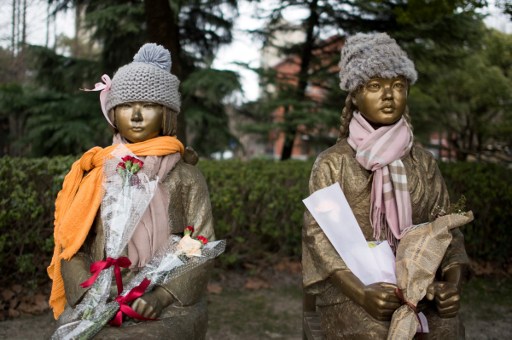China ‘comfort women’ history buried as brothels fall

This picture taken on February 1, 2017 shows statues symbolising the so-called “comfort women” in a park in Shanghai. Mainstream historians agree that around 200,000 so-called “comfort women”, mostly from Korea but also from other Asian nations including China, were forced to work in Japanese military brothels during World War II. Calls to preserve such sites, and remember their victims’ suffering, have until recently been muzzled by China’s desire to play down one of the most sensitive issues in its stormy relationship with Japan. Photo by AFP.
SHANGHAI, China – With its red-painted window frames and sooty facade, the empty two-storey building on Gongping Road is typical of many of Shanghai’s pre-World War II structures — but this one houses dark memories.
The crumbling mansion is one of 150 sites in the Chinese metropolis formerly used as “comfort stations”, part of the vast system of sexual slavery established by Japan for its invading armed forces before and during World War II.
Around 30 are believed left in the city, but these silent witnesses to history are disappearing amid rapid urban development and China’s hesitance to memorialise the painful episode.
“All these historical remains are slowly being demolished. There are fewer and fewer,” said Bao Xiaqin, an expert on China-Japan relations at the city’s Fudan University.
Mainstream historians agree that around 200,000 so-called “comfort women”, mostly from Korea but also from other Asian nations including China, were forced to work in Japanese military brothels during World War II.
Article continues after this advertisementCalls to preserve such sites, and remember their victims’ suffering, have until recently been muzzled by China’s desire to play down one of the most sensitive issues in its stormy relationship with Japan.
Article continues after this advertisementThere are glimmers of hope.
The Gongping Road site was to be razed in a redevelopment plan but was saved last year after historian Su Zhiliang highlighted the building’s past and Chinese media amplified it.
Uphill battle
But it remains an uphill battle for Su, of Shanghai Normal University, who has waged a crusade to spotlight “comfort women” suffering.
When he first began delving into the issue in the early 1990s, authorities prevented Su from publishing his research.
“The Chinese government has really not done enough. This is a wartime human rights issue, but in order to maintain good relations with Japan the government does not give the issue much support,” Su told AFP.
He now raises money for survivors, of whom there are only 17 known in China, none in Shanghai. Many were stigmatised and ostracised after the war, receiving no special government assistance.
But a rightward shift in Japanese politics under Prime Minister Shinzo Abe, and a more assertive China under President Xi Jinping, are giving oxygen to the issue, experts say.
A former “comfort station” in Nanjing, 300 kilometres (186 miles) west of Shanghai, was converted into a museum by local authorities, opening in December 2015.
Su, meanwhile, was granted permission to upgrade his display of archives into a museum, which opened in October in a building on his campus.
Just outside, a statue representing two “comfort women” — one Chinese, one Korean — also was unveiled.
China has also recently made available documents on “comfort women” from its official archives, amid an international effort to include them in the UNESCO International Memory of The World Register.
The effort proposes to recognise the Japanese system as a tragedy comparable to the Holocaust and Cambodian genocide.
“The Chinese state has latched onto this issue as a means of getting at Japan,” said Edward Vickers, a researcher at Kyushu University in Japan.
“For the Chinese Communist Party it serves the purpose of portraying Japan as some kind of international pariah to some extent, now as in the past.”
Japan bristles
Japan finally acknowledged in the early 1990s that the “comfort women” system existed. It has apologised repeatedly and offered compensation.
It now bristles at growing efforts to shine further light on the matter.
In January, Abe called on South Korea to remove a “comfort woman” statue placed defiantly outside the Japanese consulate in the city of Busan. Tokyo also recalled its ambassador in anger.
In a statement to AFP, Japan’s consulate in Shanghai condemned Su’s museum and the statue outside it as “extremely regrettable.”
“We do not consider these actions helpful for improving Japan-China relations,” it said.
Su recently began talks with Shanghai authorities on preserving a building he believes housed the first-ever “comfort station” and converting it to a museum.
Flimsy wooden partitions in the building’s interior divide it into dimly lit, makeshift apartment spaces.
Treading its creaky floorboards, an elderly woman said she — like many living in or near former Shanghai “comfort stations” — have heard of the buildings’ histories.
“After the Japanese came they could do whatever they wanted. Who could control them?” she said, peering through thick glasses.
City officials did not respond to AFP requests for comment.
“That even the first-ever ‘comfort station’ in the world has still not been fully protected, this is really regrettable, so we need to work hard,” Su said.